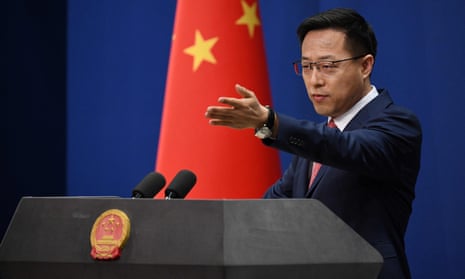The United States is “very concerned” about China’s development of hypersonic technology, the US disarmament ambassador, Robert Wood, has said, after reports that Beijing had recently launched a hypersonic missile with a nuclear capacity.
“We are very concerned by what China has been doing on the hypersonic front,” Robert Wood told reporters in Geneva.
The Financial Times reported on Saturday that Beijing had launched a nuclear-capable missile in August that circled the Earth at low orbit before narrowly missing its target. Citing multiple sources, the FT claimed the hypersonic missile was carried by a Long March rocket and that the test had been kept under wraps.
“We just don’t know how we can defend against that type of technology. Neither does China or Russia,” Wood told reporters.
But Beijing said the report was inaccurate, and the exercise was a test of reusable technology that could reduce the cost of launching spacecraft.
“According to my understanding, this test is a routine spacecraft test, used to test a reusable spacecraft technology,” the Chinese foreign ministry spokesman Zhao Lijian told reporters in a regular press briefing. “This could provide a convenient and cheap way for humans to use space for peaceful purposes.”
Zhao’s comments came days after China launched a second three-person crew to staff its space station on a six-month mission. The FT report came at a sensitive time, as China’s relationship with the US continues to deteriorate, with some commentators saying recent developments were reminiscent of those during the cold war between the Soviet Union and the west in the 20th century.
The reported launch of a hypersonic missile puzzled some observers in Washington. One US official told the FT: “We have no idea how they did this.” The FT report said Beijing’s progress in the field had “caught US intelligence by surprise”.
“The timing isn’t surprising at all,” said Tong Zhao, a senior fellow of the nuclear policy programme based at the Carnegie–Tsinghua Center for Global Policy in Beijing. “China is known to have been conducting research on new delivery technologies for some time. But even if this reported launch was a weapons test, it may be far from becoming an operational capability.
“If the FT report was true, it means that China is willing to go the extra mile with a exotic approach to penetrate the US’s missile defence,” he said, adding that the US had “long possessed a very similar and more sophisticated technology, such as the X-37B spacecraft”.
Drew Thompson, a former director for China, Taiwan and Mongolia in the Office of the Secretary of Defense in the US, said that the Department of Defense and the intelligence community have been monitoring and tracking China’s various missile programmes “for years”.
“Without transparency in China’s space programme, it is difficult to make credible denials,” he said. “I think Biden’s calculation [regarding China] changed a while ago. This just reinforces the conclusions.”
Along with China, the US, Russia and at least five other countries are working on hypersonic technology.
Hypersonic missiles can fly at more than five times the speed of sound and like ballistic missiles can deliver a nuclear warhead. But intercontinental ballistic missiles (ICBMs) fly high into space in an arc to reach their target while a hypersonic missile flies on a trajectory low in the atmosphere, potentially reaching a target more quickly.
Crucially, a hypersonic missile is manoeuvrable – making it harder to track and defend against.
Countries including the US have developed systems to defend against cruise and ballistic missiles, but their ability to track and take down a hypersonic missile remains in question.
However, US nuclear experts pointed out that ballistic missile defence (BMD) systems are intended as a shield against “rogue states” with small arsenals, and could not serve as a protection against a hail of missiles from Russia or China. Nuclear deterrence is the US strategy against such major nuclear powers.
“This is not a game-changer; US BMD is not designed to counter China’s existing missiles,” Laura Grego, a fellow at the Massachusetts Institute of Technology’s laboratory for nuclear security and policy, said on Twitter. “But it could be a hedge against the US eventually making missile defences work against Chinese ICBMs. Given the unlimited nature of US BMD programs and the capability the US has to conduct a disarming strike, US BMD continues to be a concern to China.”
Vipin Narang, a professor of nuclear security and political science at MIT, said: “One reason why the US pursues counterforce and missile defence capabilities is precisely to force adversaries to invest a lot of time and resources to develop crazy experimental systems.”
“This is a feature, not a bug, of US strategy,” Narang added.
China has been aggressively developing the technology, according to a recent report by the US Congressional Research Service.
With contributions from AFP and the Associated Press
